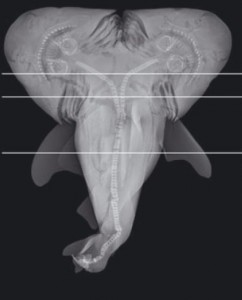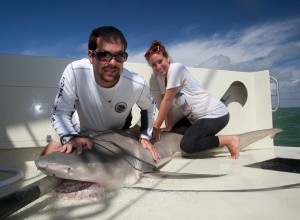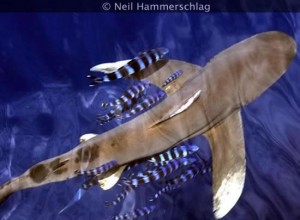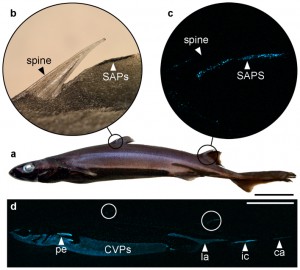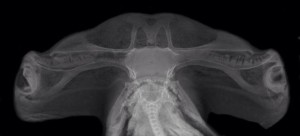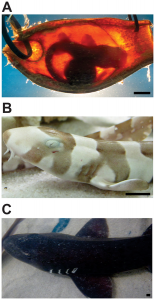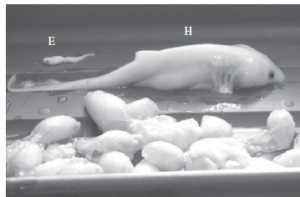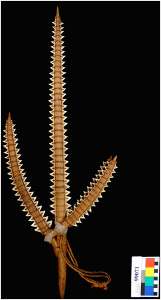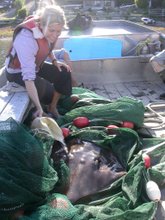Other than a certain week in August whose name we shall not speak here, 2013 was a great year for both shark science and the communication of that shark science. There were many important and fascinating discoveries, and many of the world’s top media outlets covered them. Presented here is a list of 13 amazing scientific discoveries made in 2013, in no particular ranking order. To make the list, research must have been published in a peer-reviewed scientific journal in 2013, and someone else other than me must have also thought it was awesome (i.e. it received mainstream media or blog coverage). In the interest of objectivity, I did not include any papers that I or my lab were directly involved with. Whenever possible, I’ve linked to an accessible version of the paper.
1) A two-headed bull shark!
Brief description: Researchers presented the first case of a bull shark embryo with 2 heads (the mother was caught by a Florida fishermen). In response to the most common question I received about this study, no, this animal would not have survived to adulthood. While this is a cool discovery, the broader significance is somewhat minimal. As I told science writer Douglas Main in an interview about a similar study, ”There have been a number of reports of deformed shark and ray embryos in recent years— two heads, one eye, etc. There’s no evidence to suggest these defects represent a new phenomenon or that they are harmful to shark populations as a whole.”
Media coverage highlights: A figure from this study was named one of the coolest science photos of the year by the International Science Times. It was also covered by National Geographic, the Guardian, andTIME magazine.
2) Lemon sharks return to where they were born to give birth!
Brief description: The research team at the Bimini Biological Field Station (“SharkLab”) has been sampling all of the lemon shark pups born at their island for 20 years now, which makes Bimini’s lemon sharks one of the best studied populations of wild vertebrates on Earth. Using genetic techniques, they demonstrated that adult female sharks return to the same nursery area where they were born to give birth. Individuals that they had sampled as babies came back as adults! This is significant from a conservation perspective, because some of the habitat where shark pups were born 14-17 years ago is now developed by resorts and is unsuitable habitat.
Media coverage highlights: This study was covered by BBC, Nature News, and even a strangely touching New York Times editorial.
3) Oceanic whitetip sharks migrate vast distances, but spend much of their time in protected waters.
Brief description: This study provided further evidence that the heavily exploited oceanic whitetip shark is highly migratory. As they move between many political jurisdictions, management options are complicated. However, many individuals spend the majority of their time in the protected waters of the Bahamas.
Media coverage highlights: Scientific American, BBC news.
4) Deep-sea sharks use bioluminescent “lightsabers” to defend themselves!
Brief description: While researchers have known of deep-sea bioluminescent sharks for some time, this was one of the first papers to hypothesize what the glowing spines are used for: to indiciate the presence of spines, which would be unpleasant if consumed. It also revealed that many major media outlets do not know that “lightsaber” is spelled as one word.
Brief description: Using a combination of genetic and morphometric techniques, a research team described a new “cryptic species” of hammerhead shark, an extremely important discovery at a time whenhammerheads are being proposed for an Endangered Species Act listing.
6) Sharks can learn from each other!
Brief description: Lemon sharks are able to learn behaviors by watching others of their species perform those behavior, an ability that requires higher intelligence than many believed sharks to have.
Media coverage highlights: National Geographic,BBC News.
7) Shark embryos can detect predators outside their egg, and alter their behavior!
Brief description: Shark embryos use their electrosensory system to detect when predators are outside of the egg, and they stop moving when this is the case to reduce the risk of being consumed. The application of this innate ability to shark repellent technology is also discussed.
8) Sand tiger sharks eat each other in the womb to help their dads!
Figure 1 from Chapman et al. 2013. “Size differential between the hatchling (H) and embryo(E).
Brief description: Using genetic techniques, researchers solved the mystery of why sand tiger embryos eat each other in the womb. It helps increase the chance that a given (ideally most “fit”) male’s genes will persist in the population, even if a female mates with multiple males.
9) Thresher sharks slap fish with their giant tails!
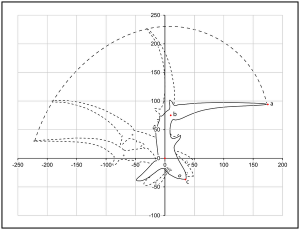
Figure 3 from Oliver et al. 2013.
” Diagram showing the method used for analysing the kinematics of a thresher shark’s tail-slap from a sequence of video still images.”
” Diagram showing the method used for analysing the kinematics of a thresher shark’s tail-slap from a sequence of video still images.”
Brief description: This research team provided the first documented evidence of what thresher shark use their enormously-long tails for: slapping fish to stun them! Watch this amazing YouTube video of the process.
10) Shark tooth weapons can tell us a lot about lost biodiversity.
Brief description: Human artifacts incorporating shark teeth show that some species that are now rare were once much more common, and can help us to detect shifting baselines in biodiversity.
11) The loss of sharks hurts a whole coral reef ecosystem.
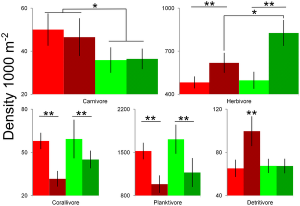
“Figure 4. Mean density of trophic groups (±95% confidence intervals) for fished (red) and non-fished (green) reefs.
The density of trophic groups across fished, non-fished, disturbed (stippled bars) and non-disturbed (solid bars) reefs are shown. **p
The density of trophic groups across fished, non-fished, disturbed (stippled bars) and non-disturbed (solid bars) reefs are shown. **p
Brief description: Shark population declines affects the whole food chain, eventually resulting in the alteration of a coral reef itself (due to changing numbers of algae-grazing herbivores).
12) Secrets behind whale shark aggregation and migration revealed!
Brief description: Whale sharks migrate vast distances, but many return to an annual aggregation (hundreds of whale sharks together) in the Gulf of Mexico every year.
Media coverage highlights: NPR News, National Geographic News.
13) The first comprehensive estimate of global shark mortality revealed some very bad news.
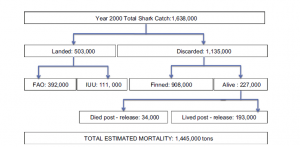
Figure 2 from Worm et al. 2013. “Estimating global shark mortality for the year 2000. Included are reported (from FAO) and illegal, unreported, and unregulated (IUU) landings as well as shark
discards. Total mortality was calculated as the total catch minus the number of sharks which survived discarding. All figures were rounded to nearest 1000 metric tons”
discards. Total mortality was calculated as the total catch minus the number of sharks which survived discarding. All figures were rounded to nearest 1000 metric tons”
Brief description: This paper provided the first comprehensive global estimate of shark mortality, as well as a (much more biologically significant but less discussed by NGOs) comparison between how many sharks are killed each year and how many are naturally replaced. Though it makes many assumptions (a necessity due to lack of data in many cases), the conclusions are startling, and it has been widely cited by conservation NGOs in the past few months as evidence that stronger conservation policies are needed.
Bonus discovery: the surprising evolutionary history of whale sharks!
Source: http://www.southernfriedscience.com/?p=16267

